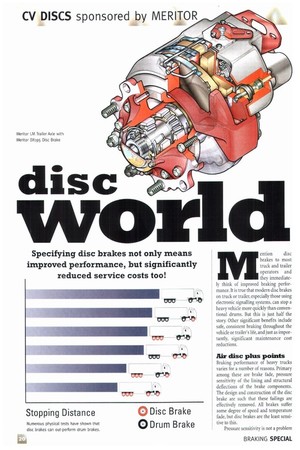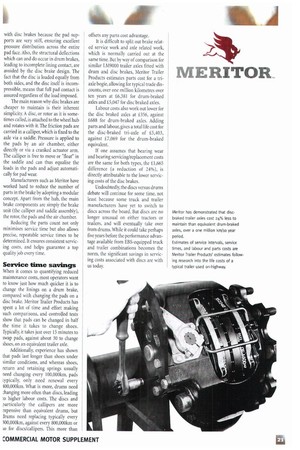disc Z 4
Page 134

Page 135

If you've noticed an error in this article please click here to report it so we can fix it.
Specifying disc brakes not only means improved performance, but significantly reduced service costs too!
ention M disc brakes to most truck and trailer operators and they immediate ly think of improved braking performance. It is true that modern disc brakes on truck or trailer, especially those using electronic signalling systems, can stop a heavy vehicle more quickly than conventional drums. But this is just half the story. Other significant benefits include safe, consistent braking throughout the vehicle or trailer's life, and just as Importantly, significant maintenance cost reductions.
Air disc plus points
Braking performance of heavy trucks varies for a number of reasons. Primary among these are brake fade, pressure sensitivity of the lining and structural deflections of the brake components. The design and construction of the disc brake are such that these failings are effectively removed. All brakes suffer some degree of speed and temperature fade, but disc brakes are the least sensitive to this, Pressure sensitivity is not a problem with disc brakes because the pad supports are very stiff, ensuring excellent pressure distribution across the entire pad face. Also, the structural deflections which can and do occur in drum brakes, leading to incomplete lining contact, are avoided by the disc brake design. The fact that the disc is loaded equally from both sides, and the disc itself is incompressible, means that full pad contact is assured regardless of the load imposed.
The main reason why disc brakes are cheaper to maintain is their inherent simplicity. A disc, or rotor as it is sometimes called, is attached to the wheel hub and rotates with it. The friction pads are carried in a calliper, which is fixed to the axle via a saddle. Pressure is applied to the pads by an air chamber, either directly or via a cranked actuator arm. The calliper is free to move or "float" in the saddle and can thus equalise the loads in the pads and adjust automatically for pad wear.
Manufacturers such as Mentor have worked hard to reduce the number of parts in the brake by adopting a modular concept. Apart from the hub, the main brake components are simply the brake unit (the calliper and saddle assembly), the rotor, the pads and the air chamber.
Reducing the parts count not only minimises service time but also allows precise, repeatable service times to be determined. It ensures consistent servicing costs, and helps guarantee a top quality job every time.
Service time savings
When it comes to quantifying reduced maintenance costs, most operators want to know just how much quicker it is to change the linings on a drum brake, compared with changing the pads on a disc brake. Mentor Trailer Products has spent a lot of time and effort making such comparisons, and controlled tests show that pads can be changed in half the time it takes to change shoes. Typically, it takes just over 15 minutes to swap pads, against about 30 to change shoes, on an equivalent trailer axle.
Additionally, experience has shown that pads last longer than shoes under similar conditions, and whereas shoes, return and retaining springs usually need changing every 100,000km, pads typically, only need renewal every 400,000km. What is more, drums need :hanging more often than discs, leading to higher labour costs. The discs and particularly the callipers are more !xpensive than equivalent drums, but 'rums need replacing typically every 300,000km, against every 800,000km or >o for discs/callipers. This more than offsets any parts cost advantage, It is difficult to split out brake related service work and axle related work, which is normally carried out at the same time. But by way of comparison for similar LM9000 trailer axles fitted with drum and disc brakes, Mentor Trailer Products estimates parts cost for a triaxle bogie, allowing for typical trade discounts, over one million kilometres over ten years at £6,381 for drum-braked axles and £5,047 for disc braked axles.
Labour costs also work out lower for the disc braked axles at £356, against £688 for drum-braked axles. Adding parts and labour, gives a total life cost for the disc-braked tri-axle of £5,403, against £7,069 for the drum-braked equivalent.
If one assumes that bearing wear and bearing servicing/replacement costs are the same for both types, the £1,665 difference (a reduction of 24%), is directly attributable to the lower servicing costs of the disc brakes.
Undoubtedly, the discs versus drums debate will continue for some time, not least because some truck and trailer manufacturers have yet to switch to discs across the board. But discs are no longer unusual on either tractors or trailers, and will eventually take over from drums. While it could take perhaps five years before the performance advantage available from EBS-equipped truck and trailer combinations becomes the norm, the significant savings in servicing costs associated with discs are with us today.








































































































































